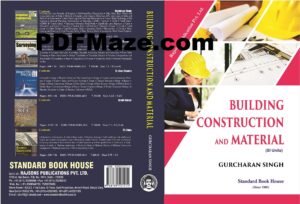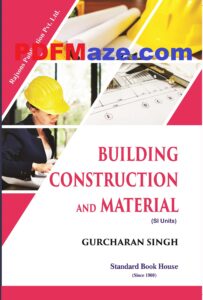

Additional Information
BUILDING MATERIALS AND CONSTRUCTION PDF

Building Materials Construction PDF
As civil engineering is based on analysis of structures and constructing and building them.Building Materials Construction PDF is used for such purposes, in order to know the materials used in construction and the different ways of constructing structures. This book is entitled as it serves in the field of engineering. Building materials have an important role to play in this modern age of technology. Although their most important use is in construction activities, no field of engineering is conceivable without their use. Also, the building materials industry is an important contributor in our national economy as its output governs both the rate and the quality of construction work.
Disclaimer:The book Building Materials Construction PDF is shared by Huzaif Jahangeer. All rights are reserved to the owner of the book. We do not claim that the book is our property and is just being circulated for fair use only.
Following are the contents of the Building Materials Construction PDF:-
- Principal Properties of Building Materials.
- Structural Clay Products
- Rocks and Stones
- Wood and Wood Products
- Materials for Making Concrete (I: Cement)
- Materials for Making Concrete (2: Aggregates)
- Materials for Making Concrete (3: Water)
- Materials for Making Concrete (4: Lime)
- Puzolanas
- Concrete
- Concrete Mix Design
- Building Mortars
- Ferrous Metals
- Non-Ferrous Metals
- Ceramic Materials
- Polymeric Materials
- Paints, Enamels and Varnishes
- Tar, Bitumen and Asphalt
- Gypsum
- Special Cements and Cement Concretes
- Miscellaneous Materials.
A.
– In simple language we can determine the materials of required physical features. Such as:
- Density.
- Bulk density.
- Density index
- Specific wt.
- Sp gravity.
- True or absolute sp. Gravity
- Apparent or mass Sp. gravity
- Porosity.
- Void ratio etc.
– Mechanical properties: The imp mech. Properties considered to be in the materials used in building construction are as follows:
- Strength
- Hardness
- Elasticity
- Plasticity
– Behaviour under stress: The common characteristics of building materials under stress are:
- Ductility
- Brittleness
- Stiffness
- Flexibility
- Toughness
- Malleability
- Hardness
B.
This unit is about the structure clay product I.e Bricks.
It deals with clay and its classification.
Its physical properties
Bricks and their classification and virtues of a good brick etc.
C.
3rd unit deals with rocks and stones. Rock forming minerals are studied and the rock classification. How stones are quarried. Seasoning and dressing of stones and their uses. Etc.
D.
It consists of intro to wood and wood products, their classification and growth. The classification of timber and its structure, seasoning, characteristics, defects, diseases and its preservation fire resistance, testing, stability etc. Properties of wood and its products
- Introduction to materials used in making of concrete
- Cement
- Introduction to materials used in making of concrete
- Aggregates
- Introduction to materials used in making of concrete
- Water
- Introduction to materials used in making of concrete
- Lime
Introduction to puzolanas, their classification, production, its activity, effects and its applications. Intro to Fly ash, Calcined puzolana, Blast furnace slag, Silica Fume and rice husk ash.
Introduction to concrete, its classification and production. Idea to water cement ratio ratio and Gel-space ratio, concrete strength, its maturity and workability, defects , durability
Physical properties of concrete and its testing and rheology.
K.
Introduction to concrete mix design, its principles, ingredients, criterion of acceptance, ingredient proportioning, Indian standard method of Design Mix.
Introduction to building mortars, its classification, characteristics, functions. Types of mortar: cement mortar, lime mortar, surkhi mortar, lime-cement mortar, mud mortar, special mortar. Idea on how to ideally select a mortar. Testing of mortar, grout and guniting process.
M.
Introduction to ferrous metals, types of ferrous metals: iron, pig iron, cast iron, wrought iron, steel, rolled steel stanchions, reinforcing steel bars. Intro to rusting and corrosion. Tensile testing of steel stanchions. Alloys of steel.
N.
Introduction to non ferrous metals. Types of non ferrous metals like copper, zinc, aluminium, lead, tin, nickel etc and their properties
O.
Introduction to ceramic materials and their classification. Intro to refractories, glass and Glass wool. Idea on what is polymorphism in ceramic materials and the mechanical, thermal and electrical properties of ceramic phases.
P.
Introduction to polymeric materials and polymerisation mechanism and depolymerisation. Types of polymers: Rubbers and plastics. Contents of plastic and its properties. Temperature effect on mechanical properties of plastic
Q.
Intro to paints, enamels and varnishes. Composition of oil paints and characteristics of ideal paint and its preparation. Painting process on different surfaces like wood surfaces, metal surfaces and plastered surfaces. Defects in painting. Introduction to enamels, distemper, water wash and colour wash. Intro to varnish, and polishes and its types like: French polish and wax polish.
R.
Intro to bitumen, tar, asphalt, and pitch. Idea to the choice of product. Their properties and their testing. Applications of bitumen materials
S.
Intro to Gypsum and effect of moisture and heat on gypsum, its setting and hardening. Classification of gypsum and its manufacture. Intro to POP, Gypsum wall plasters, hard finish plaster and gypsum plaster boards. Introduction to pyrocell.
T.
Intro to Special types of Cements and Cement Concretes
U.
Intro to different other materials used in construction
Thanks For visiting PDFmaze.com
Recommended for you

4.8 ★ • 195
Academic & Education
4.7 ★ • 422
DnD
4.8 ★ • 219
Academic & Education
4.8 ★ • 485
DnD
4.8 ★ • 344
DnD
4.6 ★ • 386
DnD
4.8 ★ • 383
DnD
4.7 ★ • 333
DnD
4.7 ★ • 342
DnD
★ • 270
Academic & Education
4.6 ★ • 5.8K
Editor's Choice
4.7 ★ • 630
DnDYou may also like

4.8 ★ • 776
Self-improvement
4.4 ★ • 501
DnD
4.3 ★ • 757
English
4.4 ★ • 624
Most Popular
4.8 ★ • 2.8K
DnD
4.9 ★ • 396
DnD
4.7 ★ • 1K
DnD
4.6 ★ • 738
DnD
4.7 ★ • 342
DnD
4.0 ★ • 385
Cluster University Srinagar
4.7 ★ • 320
DnD
4.4 ★ • 446
Self-improvement




Comments